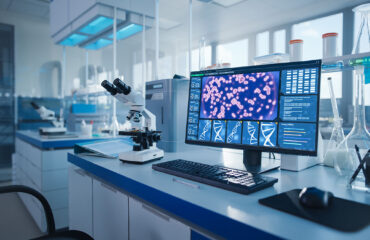Microfluidics is a field of study that deals with the behaviour, manipulation, and control of fluids in tiny volumes. This technology has revolutionised various areas of research, including biochemistry, biology, chemistry, engineering, physics, and medicine. With advancements in microfluidics technology, scientists can perform experiments and analysis with unprecedented precision, speed, and efficiency. In this article, we will discuss some of the new developments that fit within the emerging trend of miniaturisation of instruments and devices into exciting new applications.
Biomedical Applications
Microfluidics has the potential to transform biomedical research and diagnostics. One of the recent developments in this area is the use of microfluidic devices for cell sorting and analysis. Microfluidic devices can rapidly sort and analyse cells based on their physical and biochemical properties, such as size, shape, density, and surface markers. This technology can be used for a variety of applications, including cancer diagnosis, drug discovery, and personalised medicine.
Another application of microfluidics in biomedicine is the development of organ-on-a-chip technology. Organ-on-a-chip devices are microfluidic platforms that mimic the structure and function of human organs, such as the liver, lung, kidney, and heart. Such devices can be used to study the mechanisms of disease, drug metabolism, and toxicity in a more physiologically relevant environment than traditional cell culture methods.

Environmental Monitoring
Microfluidics is increasingly being applied in environmental monitoring, where it can be used to detect and analyse pollutants, pathogens, and other contaminants in air, water, and soil. One of the recent developments in this area is the use of microfluidic biosensors for water quality monitoring. Microfluidic biosensors can detect and quantify a wide range of pollutants, including heavy metals, pesticides, and pathogens, with high sensitivity and specificity. Microfluidics has the potential to improve the efficiency and accuracy of water quality monitoring, which is critical for public health and environmental protection.
Industrial Applications
Microfluidic technology also finds applications in industrial processes, such as chemical synthesis, food processing, and quality control. One of the recent developments in this area is the use of microreactors for chemical synthesis. Microreactors are microfluidic devices that enable precise control of reaction conditions, such as temperature, pressure, and flow rate, which can improve the efficiency and selectivity of chemical reactions. As such, microfluidics can help reducing the environmental impact and cost of chemical production.
Energy Applications
Microfluidics has also been applied in energy-related applications, such as fuel cells and energy harvesting. One of the recent developments in this area is the use of microfluidic fuel cells for portable electronics and microscale devices. Microfluidic fuel cells can generate electrical power from hydrogen, methanol, or other fuels with high energy density and low emissions. Although most storage solutions will use batteries, there are also possibilities to improve the efficiency and sustainability of portable power sources.
Conclusion
Microfluidics is a rapidly evolving field with diverse applications in various areas of research and industry. With the development of new microfluidic devices and techniques, scientists can explore new frontiers in science and technology, from personalised medicine to sustainable energy. However, there are still challenges that need to be addressed, such as scalability, reproducibility, and integration with other technologies. Future research in microfluidics will continue to push the boundaries of what is possible with tiny flows.





